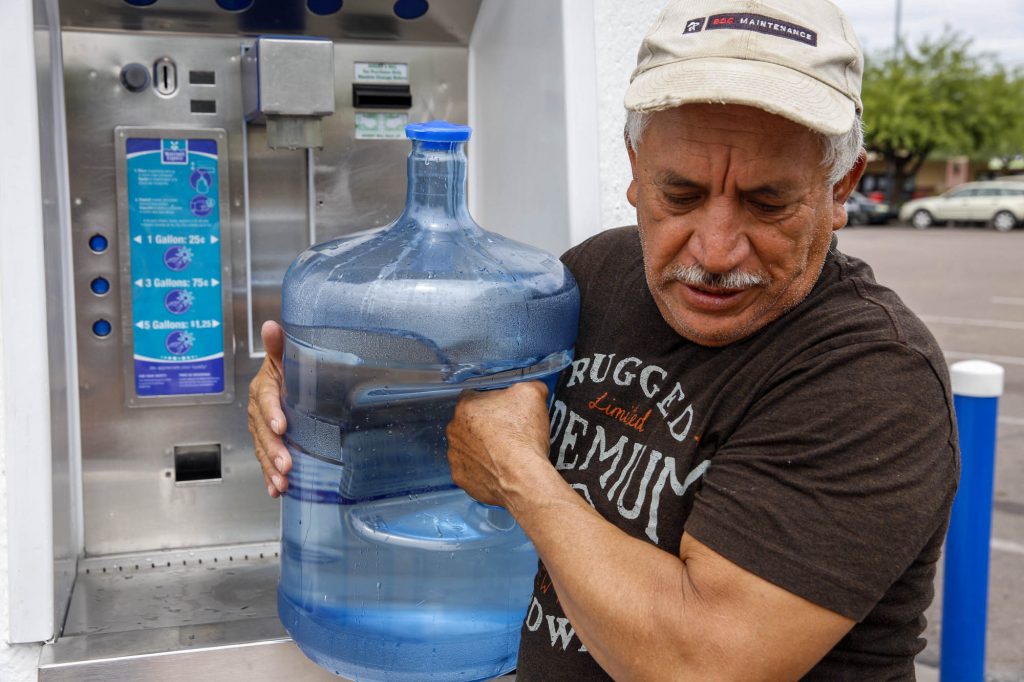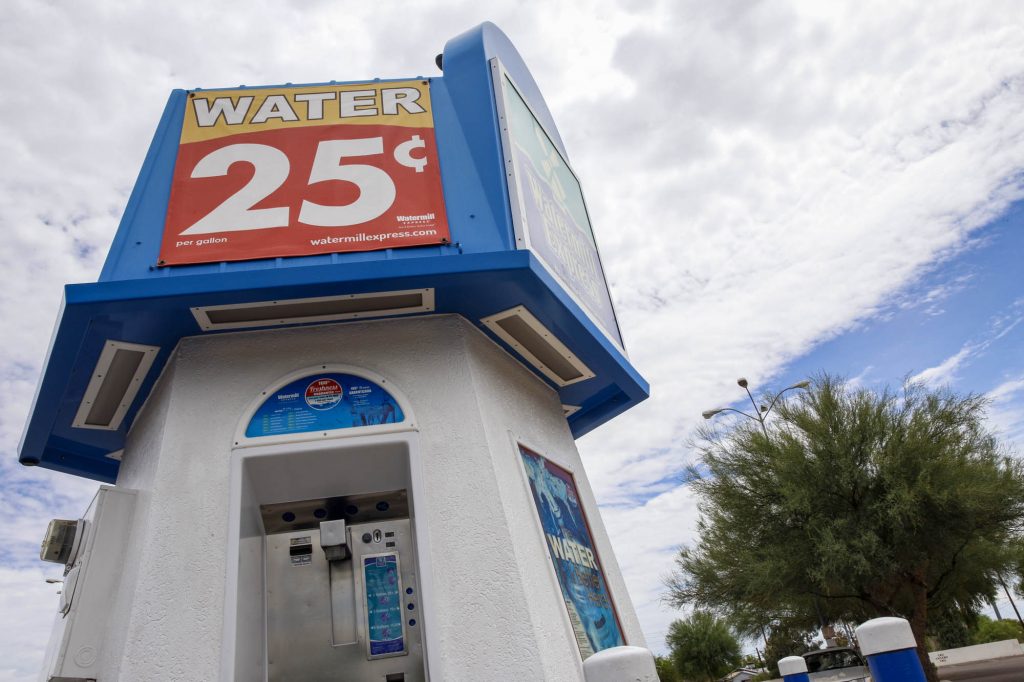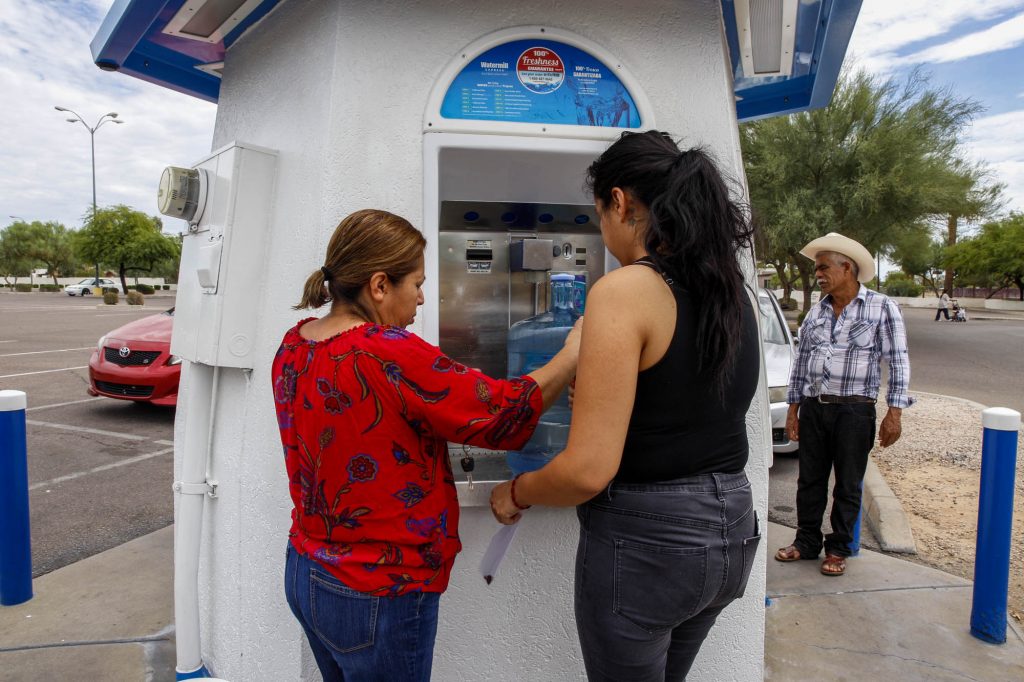Study: Latinos more likely to distrust tap water, seek other sources

Francisco Tavira, 62, earns $12 an hour at Sierra Sun Landscaping in Tempe, Arizona. He spends about $20 a month to refill his water bottles. (Photo by Andrea Jaramillo/News21)
PHOENIX – Dolores Escobar takes a 30-minute bus ride every Sunday from her house to the closest water-vending machine and carries eight empty gallon jugs with her to refill them.
During hot seasons, she travels twice a week. She spends nearly $50 a month on the water, plus her bus tickets. The Phoenix resident said she didn’t like the taste of the tap water at her home, which she said has as a “metallic taste.”
Numerous studies have found that Latinos’ consumption of tap water is significantly lower than non-Latinos’ consumption in places with predominant or growing Latino populations such as Northern California, Denver, Salt Lake City and Milwaukee.
These studies indicate that many Latinos believe their water is unsafe, don’t like the taste or the odor, or repeat the cultural patterns from their home countries, where tap water isn’t safe to drink.

Watermill Express was founded in Brighton, Colorado, and is one of many self-serve drinking water companies in the country. Its main locations are in California’s San Joaquin Valley, Arizona, Florida, New Mexico, Nevada, Texas, Illinois and Colorado. (Photo by Andrea Jaramillo/News21)
Paloma Beamer, a researcher at the University of Arizona’s Mel and Enid Zuckerman College of Public Health, led one of those studies in Nogales, Arizona. Beamer said nearly 80 percent of the 90 Latino residents surveyed didn’t drink tap water, and most of them thought it was as unsafe as drinking and driving and more unsafe than smoking. They relied on bottled water and water-vending machines.
Latinos in Tucson responded similarly. According to the 2013 American Housing Survey, Latinos were more likely than whites and African Americans to distrust their tap water and buy bottled water to replace it.
Dulce Estrada, who works at a Ranch Market in Phoenix, said she doesn’t drink or cook with tap water because she heard “the pipes are damaged” and because she never drank tap water when she lived in Mexico.

Phoenix residents Dora Godinez (left) and her daughter Diana Garcia refill their 5-gallon water jug every week because they don’t trust their tap water. (Photo by Andrea Jaramillo/News21)
Beamer’s research indicated that 73 percent of the people surveyed said they would drink the tap water if they knew it was safe – even if they didn’t like the taste.
Beamer’s team also did water-quality tests during their home visits in Nogales and found no significant difference between the tap water and the bottled or vended water Latino residents drank, except in cases where they found water stored in reusable containers that weren’t properly cleaned.
Although Beamer’s water samples came out clean, water contamination poses a problem in many other predominantly Latino communities.
For example, small-water systems that serve larger shares of Latinos in California are more likely to have higher levels of nitrate contamination than those serving larger shares of white residents, a 2011 University of California at Berkeley study found.
Not only that, Latinos are more likely to live in states with higher water-system violations reported to the Environmental Protection Agency, according to a national sample study led by Vanderbilt University’s economist William Viscusi.

Phoenix resident Diana Garcia fills water jugs to take them home. (Photo by Andrea Jaramillo/News21)
Latinos reported more pipe leakage problems than whites, although less than African Americans and Native Americans, according to the 2015 American Housing Survey. Leaky water pipes can be a sign of corrosion or deterioration, which affects water quality.
Latinos also spend more money in bottled water. Viscusi’s study found that Latino households spend $2.17 more a month than non-Latinos, yet their median income is 24 percent below the national average.
But the concern isn’t just financial. Beamer said that not drinking tap water increases Latinos’ risk of developing diabetes because they tend to consume sugary drinks instead of water.
According to the Centers for Disease Control and Prevention, Latinos are more likely to develop Type 2 diabetes than whites.
To see the full News21 report on “Troubled Water,” go troubledwater.news21.com on Aug. 14.